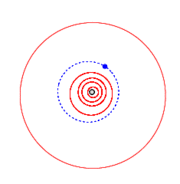9971 Ishihara
 Orbit of Ishihara (blue), inner planets and Jupiter (outermost) | |
| Discovery [1] | |
|---|---|
| Discovered by |
K. Endate K. Watanabe |
| Discovery site | Kitami Observatory |
| Discovery date | 16 April 1993 |
| Designations | |
| MPC designation | (9971) Ishihara |
Named after |
Takahiro Ishihara (Japanese astronomer)[2] |
|
1993 HS · 1991 YC2 1996 EU1 | |
| main-belt · Flora [3] | |
| Orbital characteristics [1] | |
| Epoch 4 September 2017 (JD 2458000.5) | |
| Uncertainty parameter 0 | |
| Observation arc | 24.91 yr (9,097 days) |
| Aphelion | 2.4465 AU |
| Perihelion | 1.9164 AU |
| 2.1814 AU | |
| Eccentricity | 0.1215 |
| 3.22 yr (1,177 days) | |
| 158.69° | |
| 0° 18m 21.24s / day | |
| Inclination | 2.7482° |
| 20.550° | |
| 246.01° | |
| Physical characteristics | |
| Dimensions |
3.74 km (calculated)[3] 4.986±0.053 km[4] 5.012±0.069 km[5] |
|
6.715±0.0036 h[6] 6.71574±0.00001 h[7] | |
|
0.2328±0.0281[5] 0.235±0.027[4] 0.24 (assumed)[3] | |
| S [3] | |
| 13.7[5] · 13.9[1] · 13.852±0.006 (R)[6] · 14.26±0.22[8] · 14.3[3] | |
|
| |
9971 Ishihara, provisional designation 1993 HS, is a stony Florian asteroid from the inner regions of the asteroid belt, approximately 4 to 5 kilometers in diameter. It was discovered by Japanese amateur astronomers Kin Endate and Kazuro Watanabe at Kitami Observatory on 16 April 1993,[9] and named after Takahiro Ishihara, president of the astronomical society at Hiroshima.[2]
Orbit and classification
Ishihara is a member of the Flora family, one of the largest families of stony asteroids in the asteroid belt. It orbits the Sun in the inner main-belt at a distance of 1.9–2.4 AU once every 3 years and 3 months (1,177 days). Its orbit has an eccentricity of 0.12 and an inclination of 3° with respect to the ecliptic.[1] It was first identified as 1991 YC2 at Karl Schwarzschild Observatory in 1991, extending the body's observation arc by approximately 2 years prior to its official discovery at Kitami.[9]
Physical characteristics
Rotation and poles
In January 2012, a rotational lightcurve of Ishihara was obtained from photometric observations by astronomers at the Palomar Transient Factory in California. Lightcurve analysis gave a rotation period of 6.715 hours with a brightness amplitude of 1.06 in magnitude, which indicates that the body has a non-spheroidal shape (U=2).[6]
A 2016-published lightcurve, using modeled photometric data from the Lowell Photometric Database (LPD), gave a concurring period of 6.71574 hours (U=n.a.), as well as a spin axis of (42.0°, 76.0°) in ecliptic coordinates (λ, β).[7]
Diameter and albedo
According to the survey carried out by NASA's Wide-field Infrared Survey Explorer with its subsequent NEOWISE mission, Ishihara measures 4.986 and 5.012 kilometers in diameter and its surface has an albedo of 0.235 and 0.2328, respectively.[4][5] The Collaborative Asteroid Lightcurve Link assumes an albedo of 0.24 – derived from 8 Flora, a S-type asteroid and the family's largest member and namesake – and calculates a diameter of 3.74 kilometers with an absolute magnitude of 14.3.[3]
Naming
This minor planet was named after Takahiro Ishihara (born 1961), an observer of comets, communicator of astronomy, and former president of the astronomical society at Hiroshima (1987–1997).[2] The official naming citation was published by the Minor Planet Center on 6 January 2003 (M.P.C. 47298).[10]
References
- 1 2 3 4 "JPL Small-Body Database Browser: 9971 Ishihara (1993 HS)" (2016-11-23 last obs.). Jet Propulsion Laboratory. Retrieved 22 June 2017.
- 1 2 3 Schmadel, Lutz D. (2006). Dictionary of Minor Planet Names – (9971) Ishihara, Addendum to Fifth Edition: 2003–2005. Springer Berlin Heidelberg. p. 49. ISBN 978-3-540-34361-5. Retrieved 10 April 2017.
- 1 2 3 4 5 6 "LCDB Data for (9971) Ishihara". Asteroid Lightcurve Database (LCDB). Retrieved 10 April 2017.
- 1 2 3 Masiero, Joseph R.; Mainzer, A. K.; Grav, T.; Bauer, J. M.; Cutri, R. M.; Dailey, J.; et al. (November 2011). "Main Belt Asteroids with WISE/NEOWISE. I. Preliminary Albedos and Diameters". The Astrophysical Journal. 741 (2): 20. arXiv:1109.4096. Bibcode:2011ApJ...741...68M. doi:10.1088/0004-637X/741/2/68. Retrieved 10 April 2017.
- 1 2 3 4 Mainzer, A.; Grav, T.; Masiero, J.; Hand, E.; Bauer, J.; Tholen, D.; et al. (November 2011). "NEOWISE Studies of Spectrophotometrically Classified Asteroids: Preliminary Results" (PDF). The Astrophysical Journal. 741 (2): 25. arXiv:1109.6407. Bibcode:2011ApJ...741...90M. doi:10.1088/0004-637X/741/2/90. Retrieved 10 April 2017.
- 1 2 3 Waszczak, Adam; Chang, Chan-Kao; Ofek, Eran O.; Laher, Russ; Masci, Frank; Levitan, David; et al. (September 2015). "Asteroid Light Curves from the Palomar Transient Factory Survey: Rotation Periods and Phase Functions from Sparse Photometry". The Astronomical Journal. 150 (3): 35. arXiv:1504.04041. Bibcode:2015AJ....150...75W. doi:10.1088/0004-6256/150/3/75. Retrieved 10 April 2017.
- 1 2 Durech, J.; Hanus, J.; Oszkiewicz, D.; Vanco, R. (March 2016). "Asteroid models from the Lowell photometric database". Astronomy and Astrophysics. 587: 6. arXiv:1601.02909. Bibcode:2016A&A...587A..48D. doi:10.1051/0004-6361/201527573. Retrieved 10 April 2017.
- ↑ Veres, Peter; Jedicke, Robert; Fitzsimmons, Alan; Denneau, Larry; Granvik, Mikael; Bolin, Bryce; et al. (November 2015). "Absolute magnitudes and slope parameters for 250,000 asteroids observed by Pan-STARRS PS1 - Preliminary results". Icarus. 261: 34–47. arXiv:1506.00762. Bibcode:2015Icar..261...34V. doi:10.1016/j.icarus.2015.08.007. Retrieved 10 April 2017.
- 1 2 "9971 Ishihara (1993 HS)". Minor Planet Center. Retrieved 10 April 2017.
- ↑ "MPC/MPO/MPS Archive". Minor Planet Center. Retrieved 10 April 2017.
External links
- Asteroid Lightcurve Database (LCDB), query form (info)
- Dictionary of Minor Planet Names, Google books
- Asteroids and comets rotation curves, CdR – Observatoire de Genève, Raoul Behrend
- Discovery Circumstances: Numbered Minor Planets (5001)-(10000) – Minor Planet Center
- 9971 Ishihara at the JPL Small-Body Database
